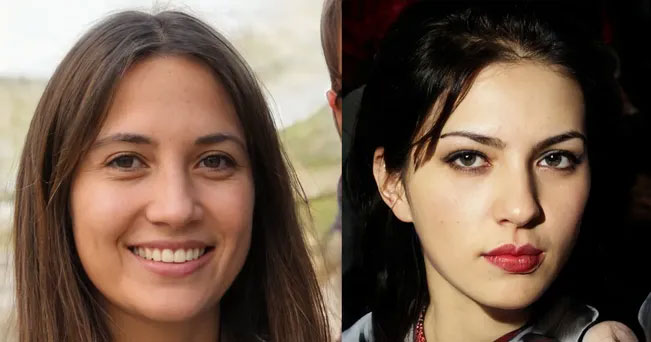Chrome extension can detect fake photos up to 99.29% accuracy
Chrome Extension (extension for Chrome browser) can identify fake images on profiles (user profiles) with up to 99.29% accuracy.
According to Petapixel, V7 Labs has created a new piece of software based on artificial intelligence (AI) that acts as a Google Chrome extension. It is capable of detecting artificially created profile pictures – like the one you see above – with a claimed accuracy of 99.28%.

This utility is capable of detecting profile pictures created by artificial methods.
V7 Labs is a software company that designs products to automate visual tasks. The company says that people now rely heavily on images to make certain decisions (for example, make friends with a stranger on social media after seeing a photo in their profile). And they are working towards making 'deep learning' technology more powerful. Any business can then deploy state-of-the-art AI technology for image recognition from a single platform.
Detect fake photos on profile
Alberto Rizzoli, one of the founders of V7 Labs, describes new software designed to help curb misinformation in the network environment. He demonstrated the feature in a video on the Loom platform.
"There's a lot of misleading content on social media these days, and many people share this content using fake profiles," said Rizzoli. We've created a Chrome extension that can detect if the profile picture is a real person or an AI-generated portrait'.
He also shows how the extension works by checking out the profile picture of someone who recently added him on LinkedIn. With just one click, the extension was able to quickly determine that she was a fake. In that particular example, there are some signs that the photo isn't real, such as a messy earring and weird looking pupils. However, these are only really noticed upon close inspection and fake profiles still deceive many internet users.
Rizzoli continues a second example with an extension's recognition accuracy close to 100%.
He explains that many of these photos were created on the website This Person doesn't Exist. This website uses an AI face generator powered by NVIDIA StyleGAN, a neural network developed in 2018. This website was created by a software engineer from San Francisco and is very simple to use. . When the web page loads, it just shows a new AI-generated face. Every time the page is refreshed, a new face appears (these faces are generated by the AI from a 512-dimensional vector).
Fight dangerous misinformation
Rizzoli's first few examples seem relatively innocuous, but he says his software can better combat fake news and misinformation.
"It's something that's growing quite a bit, especially on Amazon, where a lot of authors sell books," he said. The bad guys just need a few taps to create a fake profile, then market the fake books for cheaper than the real book'.
Of course, the situation of faking other people's profiles also happens on social networks. Rizzoli pointed to the example of a Twitter user with an AI-generated face spreading misinformation about the war in Ukraine. This information has a very 'negative' influence on economic and social life.
He told pitaxel: 'This Chrome extension will help authorities (and ordinary people) detect and report profiles that spread fake news. These profiles create information chaos, especially on issues like the conflict between Russia and Ukraine'.
Currently, this extension only works on images created by GaN. So it can't detect high quality photos in video (at least for now).
- What do you do when your baby gets chrome?
- The most annoying thing about Chrome browser is about to be fixed
- Instructions to enable full URL display in Google Chrome
- How to make Google Chrome browser run much faster
- Why when losing Google Chrome network for users to play dinosaur games?
- Decode the mysterious ghost photos
- 4 tips to help Google Chrome run faster
- How has the world transferred from IE to Chrome?
- How to detect fake mink coffee
- How to recognize fake beef with just one sheet of paper, everyone can do it
- What happens if you open 100 Chrome tabs on your phone?
- Instructions for syncing Chrome data on multiple devices
 What is the Snapdragon SiP chip?
What is the Snapdragon SiP chip? How to create a yellow circle around the mouse cursor on Windows
How to create a yellow circle around the mouse cursor on Windows Edit the Boot.ini file in Windows XP
Edit the Boot.ini file in Windows XP 3 ways to restart the remote computer via the Internet
3 ways to restart the remote computer via the Internet Fake Beef in China: The Horrifying Secret Behind Familiar Dishes
Fake Beef in China: The Horrifying Secret Behind Familiar Dishes  How to distinguish real and fake soft drinks
How to distinguish real and fake soft drinks  Simple and useful tips to help you distinguish between real and fake electronics
Simple and useful tips to help you distinguish between real and fake electronics  Deepfake - the most dangerous weapon born in the digital age
Deepfake - the most dangerous weapon born in the digital age  Revealing the secrets of fake doors in the tomb of Pharaoh
Revealing the secrets of fake doors in the tomb of Pharaoh  5 artifacts 'fake' cause 'shake' of the world
5 artifacts 'fake' cause 'shake' of the world 